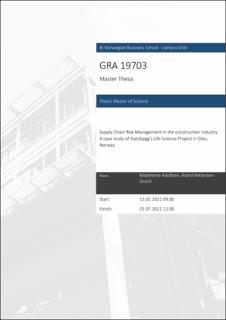| dc.description.abstract | Large-scale construction projects involve numerous contractors, actors, large investments and budgets. They often span over many years to complete and are known for high fragmentation, low productivity, conflicts and cost and time overruns (Bankvall et al., 2010; Fearne & Fowler, 2006). Consequently, SCRs are prominent in these projects due to the complexity, uncertainty and external influence. By focusing on SCR, SCRM and logistics, the industry can increase productivity, efficiency, resilience and robustness. There is much research on the RM field, but there is a lack of literature and empirical evidence on SCRM in large-scale construction projects, which this thesis will contribute. This thesis will further investigate the perception of SCM and SCRM in large-scale construction projects through a qualitative research method to provide an answer to the RQ: How can actors in large-scale construction projects mitigate supply chain risks? We have conducted an exploratory case study of the LSP in collaboration with SB to answer to the RQ and overall objective. Data were collected through semi- structured interviews and documentation provided from SB.
The findings from our study are how SCRM and mitigation strategies are deemed valuable to decrease SCR and complexity of a large-scale construction project. It was further discovered that mitigation strategies often need a combination of strategies to be successful. One of our main findings from the data collection was the impact of information, collaboration, labelling issues and that digitalization can create synergies improving project performance. Categorizing SCR provided an overview of the identified SCR and made it easier to see how the SCRs connect to each other, giving us in-depth knowledge about the identified SCRs.
Mitigation strategies will decrease the probability and impact of SCRs occurring in large-scale construction projects, which will further amplify flexibility, transparency and collaboration in the CSC. This contributes large-scale construction projects to become more efficient and resilient with a CSC that works efficiently, with lower costs and better collaboration with the actors.
Consequently, proper SCR identification and mitigation can reduce the disruptions in the LSP and large-scale construction project in general, making the goal of the five R’s achievable. | en_US |
